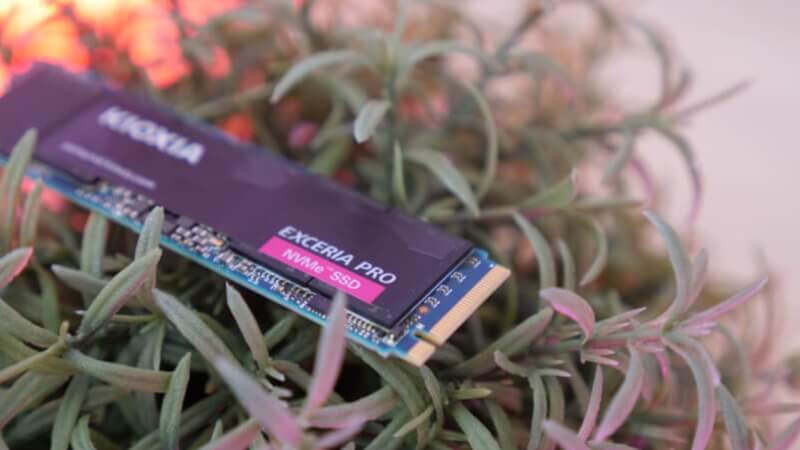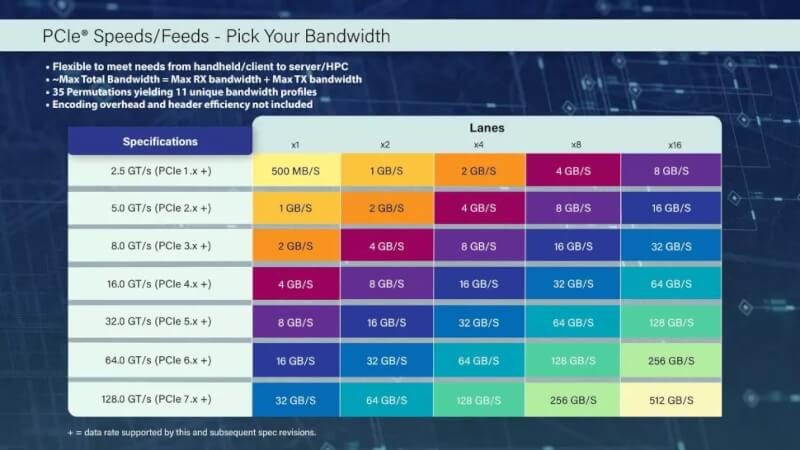PCIe 7.0 and 60GB/s SSDs will arrive in 2025

PCI Express 7.0 is on the way, but you don't need to start saving for a new motherboard just yet. PCI-SIG just released the 0.5 version and the final version is expected to be released in 2025. This means that supported devices will likely not launch until 2026 and that 2027-28 will likely be the years we see a wider rollout.
Initially, PCIe 7.0 will be far more relevant to the enterprise market, where bandwidth-demanding applications such as AI and networking will benefit from it. Either way, the PC market is not saturated with PCIe 5.0 devices, and PCIe 6.0 has yet to make its way into our gaming PCs.
PCI Express bandwidth doubles with each generation, so PCIe 7.0 will deliver a maximum data rate of up to 128 GT/s. It is 8 times faster than PCIe 4.0 and 4 times faster than PCIe 5.0. This means that PCIe 7.0 is capable of delivering up to 512 GB/s bi-directional throughput via a x16 connection and 128 GB/s for a x4 connection. More bandwidth will certainly be beneficial for CPU-to-chipset connections, meaning more integrated devices like 10G networks, WiFi 7, USB 4 and Thunderbolt 4 will all be able to run on a consumer motherboard without compromise.

And imagine what all that bandwidth could mean for PCIe 7.0 SSDs. In the coming years, a PCIe 7.0 x4 SSD could approach sequential transfer speeds of up to 60 GB/s. We'll need some serious advances in SSD controller and NAND flash technologies to see speeds of that magnitude. But still, it's an attractive proposition.
As for graphics cards, you are well protected for many years to come with PCIe 4.0. A PCIe 4.0 x16 connection is not a bottleneck for an RTX 4090, while Nvidia and AMD have no problem offering mid-range cards with x8 connections. Next generation graphics cards will probably all have PCIe 5.0 support, but it will be many years before we see a PCIe 7.0 graphics card.
If we look at PCIe x16 or x4 transfer rates it is not the most interesting. I'm more interested in having multiple x1 or x2 connections. I like the idea of being able to have four PCIe 7.0 x1 SSDs on a card that fits in a x4 slot.
Each drive could still support speeds of around 14GB/s - the same speeds as the best PCIe 5.0 drives. That will take some of the burden off motherboard manufacturers, who currently have to fill half the motherboard with space-hogging M.2 slots.
Modern motherboards have complicated electrical layouts and require large heatsinks. Often it is necessary to remove the graphics card and take out small screws to access a slot when you want to add a new SSD.
It will take a few years for PCIe 7.0 devices to hit store shelves. PCIe 5.0 is not yet widespread and PCIe 6.0 is still in its infancy. But it's nice to wonder what PCIe 7.0 will mean for gaming PCs as we approach 2030.
Latest motherboard
-
25 Aprmotherboard
-
24 Aprmotherboard
Gigabyte's XTREME Prestige announced
-
04 Aprmotherboard
PCIe 7.0 and 60GB/s SSDs will arrive in 2025
-
15 Marmotherboard
ASUS BIOS update supports 256GB DDR5
-
28 Febmotherboard
ASUS TUF Gaming B650-Plus WiFi
-
14 Febmotherboard
ASRock B650E TaiChi
-
09 Febmotherboard
ASRock's latest 600/700 series BIOS updates
-
30 Janmotherboard
MSI launches budget-friendly MPOWER Z790M motherbo
Most read motherboard
Latest motherboard
-
25 Aprmotherboard
ASRock & Biostar Confirm Ryzen 9000 Support
-
24 Aprmotherboard
Gigabyte's XTREME Prestige announced
-
04 Aprmotherboard
PCIe 7.0 and 60GB/s SSDs will arrive in 2025
-
15 Marmotherboard
ASUS BIOS update supports 256GB DDR5
-
28 Febmotherboard
ASUS TUF Gaming B650-Plus WiFi
-
14 Febmotherboard
ASRock B650E TaiChi
-
09 Febmotherboard
ASRock's latest 600/700 series BIOS updates
-
30 Janmotherboard
MSI launches budget-friendly MPOWER Z790M motherbo






